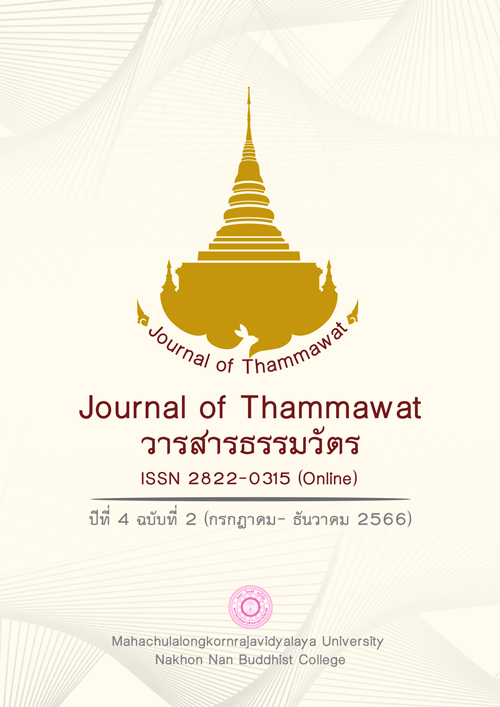Buddhist Principles appearing in the Succession Tradition of the Thai Lue People, Muang Ngoen, Xayaburi Province, People's Democratic Republic of Laos
Main Article Content
Abstract
The objectives of this article were: 1) to study the history of the fate inheriting tradition of Thai Lue people, Muang Ngoen, Xayaburi province, People's Democratic Republic of Laos, 2) to study Buddhist mantra chant which occurred in the tradition of inheriting the fate of Thai Lue people, Muang Ngoen, Muang Ngoen, Xayaburi province, People's Democratic Republic of Laos, 3) Analyze Buddhist principles found in the tradition of inheriting the fate of the Thai Lue people, Muang Ngoen, Muang Ngoen, Xayaburi province, People's Democratic Republic of Laos. This research was qualitative research, studied documents and fieldwork to gather data and interview and analyzed the data descriptively.
The results of the research had found that the history of the destiny tradition of the Tai Lue people, Mueang Ngen, Xayaburi Province, was based on two beliefs: 1) Buddhism was the origin of the destiny tradition with beliefs about renewal from Buddhist literature. 2) It was a belief that arose only for the individual, it was the belief of a person who believed in the matter of magic and auspicious spells or astrology. That performed the fate ceremony would dispel all dangers from one’s body and heal from existing illnesses. Buddhist mantras were what create faith and belief in their power to cure suffering, sorrow, sickness, and restlessness, and to eliminate dangers. The principles that appeared in the fate-descending tradition of the Tai Lue people, Mueang Ngen, Xayaburi Province, were inserted into the Dhamma scriptures that were used in the sermon for the destiny-descending ceremony. Two principles appeared, namely the principle of miracles 3 and the principle of merit-making 3.
Article Details

This work is licensed under a Creative Commons Attribution-NonCommercial-NoDerivatives 4.0 International License.
References
กริช อินเต็ม. (2557). ศึกษาวิเคราะห์หลักพุทธธรรมที่ปรากฏในวรรณกรรมพระพุทธศาสนาล้านนาเรื่อง มหา วิบาก. วารสารนวัตกรรมการจัดการศึกษาและการวิจัย, 5(1), 223-232.
ขจัดภัย บุรุษพัฒน์. (2537). แลลาว. กรุงเทพฯ: แพร่วิทยา.
คำแดง กมมะดำ และ คำแพง ทิบมนตรี. (2535). ท่องเที่ยวบรรดาชนเผ่าอยู่ลาว. เวียงจันทน์: สถาบันค้นคว้าวัฒนธรรมและสังคม.
ธนิด อยู่โพธิ์. (2547). อานุภาพพระปริตต์. (พิมพ์ครั้งที่ 3). กรุงเทพฯ: อมรินทร์พรินดิ้งแอนด์พับลิซซิ่ง.
ประชัน รักพงษ์. (2537). โครงการพิพิธภัณฑ์วัฒนธรรมและชาติพันธุ์ล้านนา. เชียงใหม่: โรงพิมพ์มหาวิทยาลัย ราชภัฏเชียงใหม่.
ประชัน รักพงษ์. (2540). การศึกษาวัฒนธรรมพื้นบ้านไทลื้อในภาคเหนือของ สปป.ลาว. วารสารสหวิทยาการมนุษยศาสตร์และสังคมศาสตร์, 6(1), 234-245.
พุ่มพวง อภิวงค์. (2537). คติชนกับการสร้างอัตลักษณ์ทางชาติพันธุ์ของชาวไทลื้อ บ้านห้วยโก๋น อำเภอเฉลิมพระเกียรติ จังหวัดน่าน. วารสารนวัตกรรมการจัดการศึกษาและการวิจัย, 4(3), 83-92.
พระราชเขมากร. (2557). พระวิทยากรเสวนา (สืบชะตาล้านนา: แนวคิดและการเสริมสร้างความสัมพันธ์ทางสังคมและจิตวิญญาณของชุมชนในล้านนา), ณ. วัดพระบาทมิ่งเมืองวรวิหาร อำเภอเมืองจังหวัดแพร่ เมื่อวันที่ 3 พฤษภาคม.
สุรสิงห์สำรวม ฉิมพะเยาว์. (2526). ภาษาสัญลักษณ์ในพิธีสืบชะตา: ตัวอย่างวรรณกรรมเงียบ. ใน เอกสารประกอบการสัมมนาเรื่องวัฒนธรรมพื้นบ้าน: คติความเชื่อศิลปกรรมและภาษา, กรุงเทพฯ: จุฬาลงกรณ์มหาวิทยาลัย.
สีสะเหลียว สะแหวงสีกสา. (2532). ภูมิศาสตร์ลาว. เวียงจันทน์: สถาบันค้นคว้าวิทยาศาสตร์และสังคม.


